by Andrew Montiveo

John Palaeologus / Wikimedia Commons
In the 55 years he walked this earth, John Palaeologus left behind no great monument, no work of scholarship, and–despite three marriages–no children. Instead, he left behind his image, and that was enough for him to be remembered by. That image was to give John a long and colorful afterlife, one that traversed the boundaries of time, space, and media. More importantly, his image was destined to be the ancestor to the most pervasive and perplexing of modern phenomena–the meme.
John was the eighty-sixth ruler of Byzantium, the medieval heart of Orthodox Christendom.1 He ascended the throne in 1425, becoming the eighth member of the House Palaiologos to rule the Byzantine Empire. Thirteen years after his ascent, he journeyed to Italy to meet with Pope Eugenius IV and try to end nearly four centuries of schism.
During this visit, John encountered Antonio di Pisanello, an artist in the service of Niccolò III, marquis of Ferrara. The marquis commissioned Pisanello to design a medallion that would commemorate John’s visit to the city.2 The emperor’s profile would be on the obverse side; a scene of him on horseback would be on the reverse.
The first examples appeared less than a year later. By then, the Byzantine and Roman delegations signed a ceremonial union of churches. However, neither the union nor its signatories had much time left on this earth: Eugenius died in 1447, and John in ‘48. Byzantium fell to the Turks five years later, ending the symbolic reunification of Christendom. John, his sole achievement undone, seemed destined to be forgotten.
And yet he wasn’t. John–or at least his likeness, his mîmêma–survived. Orders for Pisanello’s medallion continued until the artist’s death in 1455. The papacy, enamored with the design, went so far as to have its own artist, Antonio di Filarete, reproduce Pisanello’s medallion en masse.3 By the 1460s, John’s likeness could be seen on frescoes, tapestries, ceramics, busts, doorways, and even funerary monuments.
John’s image was taking on a life of its own. The subject may have been dead, but his mîmêma was thriving across different media. It appeared that John’s epilogue was to last much longer than anyone imagined.
The portraiture of Pisanello and Filarete only touched upon the value of John’s image. He was not just some opulently attired monarch: He was, to Italians of the time, a glimpse to a distant epoch. Even in the fifteenth century, Byzantine society held a reputation as a curator of Greco-Roman antiquity, an antiquity that Italians of the Renaissance were obsessed with reviving.
To the philosopher, John was a link to Socrates, Plato, and Aristotle. To the theologian, John was a living glimpse to the era of Christ and the Apostles. To the artist, John, exotically attired, was a work of art in himself. For everyone, John’s image was a graspable, illustrated vestige of a time, perhaps a place, lost to the ages. He was, in a sense, the embodiment of nostalgia.
Where Pisanello and Filarete replicated John’s likeness, later artists took liberty with the emperor’s image. Benozzo Gozzoli cast John as one of the three Biblical Magi on a tapestry for Cosimo de’ Medici. Piero della Francesca cast the emperor in the role of Constantine the Great. Hans Holbein the Elder placed John in the seat of Pontius Pilate, sentencing the Christian messiah to his grim fate. The mîmêma was becoming the meme.

John Palaeologus as Pontius Pialte / Wikimedia Commons
The following decades saw John be everyone and everywhere. He became Theseus, mythical hero; Lycurgus, Spartan lawgiver; Averroes, Iberian mathematician; and even Mehmed II, Turkish sultan and conqueror of Byzantium. He was at the scene of Jesus Christ’s resurrection in Emmaus, Saint Catherine’s martyrdom in Alexandria, and Maxentius’s demise outside Rome.4 He was everything: a pagan, a Christian, a Muslim, a reference, an allegory. He was whatever the artist needed him to be.

John VII Paleologos by Benozzo Gozzoli, detail of the back wall of the Cappella dei Magi in the Palazzo Medici Riccardi, Florence, Italy /Alinari Archives / Universal Images Group
Time, so often an enemy, worked to his image’s benefit. The more time passed, the more malleable John’s image became–though at the expense of context. The man behind the image was forgotten as the ages progressed. John’s sole twentieth century cameo, asreported by Alessandra Pedersoli of Engramma Magazine, was as a nameless “Oriental Prince” on a Scottish liquor bottle, dated 1970.
Then came the Digital Age, with its countless blogs and wikis, restoring that long-absent context. John was no longer relegated to being some random “Oriental Prince” on a liquor set; but rather, he resumed his role as John Palaeologus, distant heir to Augustus and penultimate emperor of Byzantium.
History has seen so many figures resort to desperate, sometimes catastrophic, measures in the hopes of being remembered: the building of monoliths, the founding of cities, or the conquest of nations. Sometimes it works. Sometimes it doesn’t.
Other times, an image is all it takes.
Andrew Montiveo is a writer based in Los Angeles. He graduated from the University of California, Irvine, with a degree in film and media studies (and a minor in history) in 2012. He co-founded 4-Pistons Media, a small production company, in 2013.
Photo credit: Gozzoli, Benozzo, Benozzo di Lese, known as. Fine Art. Encyclopædia Britannica ImageQuest. Web. 10 Mar 2016. http://quest.eb.com/search/153_2391596/1/153_2391596/cite

 Cicero denounces Catline.
Cicero denounces Catline.

 Charles Dickens
Charles Dickens


